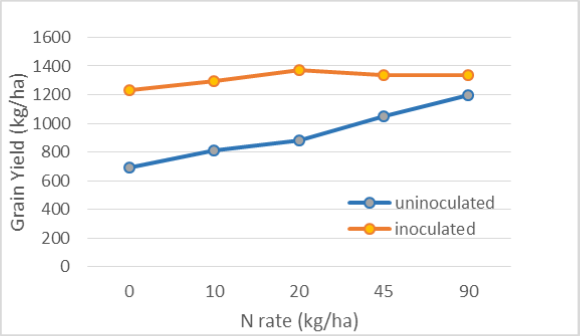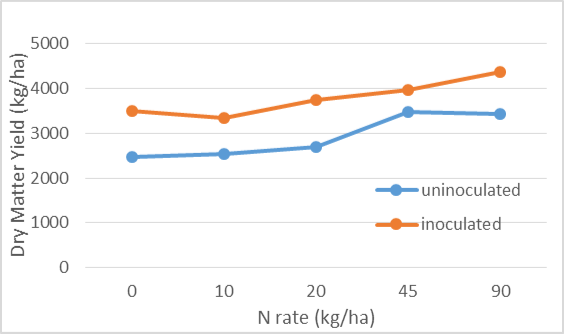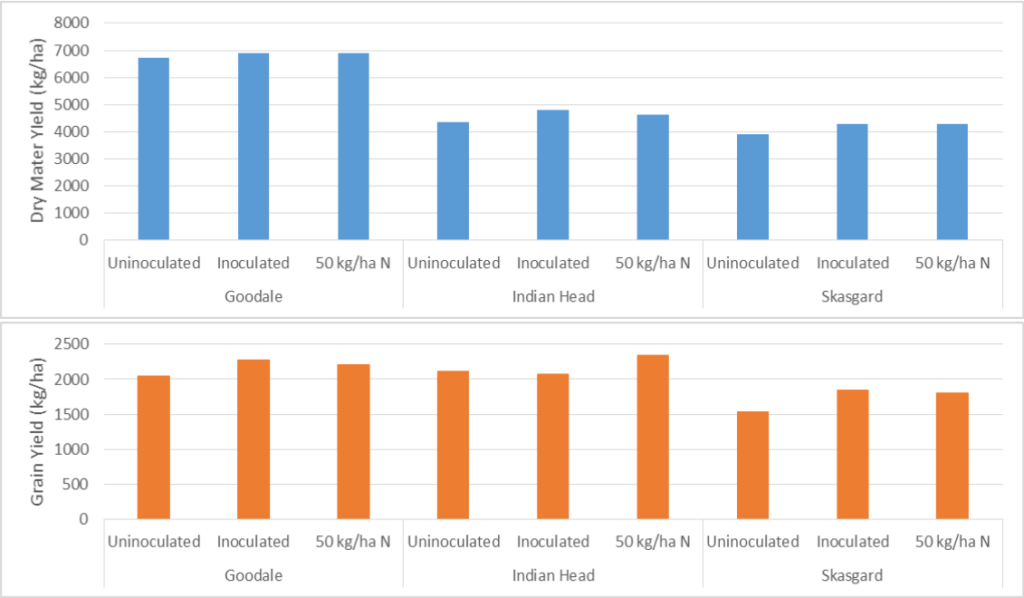Dry conditions during a growing season may result in reduced yields. Fall soil tests following a season with reduced yields can show ranges of 40 to well over 100 pounds per acre of available nitrogen (N). With higher residual nitrogen in the soil, the choice of crops to grow the following year should be carefully considered as nitrogen is a valuable crop nutrient,
Often recommendations are made to grow crops such as canola that may use up much of the residual nitrogen. Where crop rotations suggest, or there is a preference for growing a pulse, questions begin to arise. Pulses, such as lentils, are a nitrogen fixing crop which means they are able to fix nitrogen from the air and do not rely on soil residual nitrogen as much as other non-nitrogen fixing crops. The impact of added nitrogen or high levels of soil residual nitrogen on a pulse crop has not been found to impact yield, but may result in reduced nitrogen fixation.
Study #1
Research by E. Bremer and colleagues in 1987 at Semas, Foam Lake and Kindersley, SK evaluated the impact of a range of nitrogen rates from 0-90 kg/ha (0—80 lb/ac) on lentil yield and plant biomass. Results of the study indicated that there was little impact on yield as long as an inoculant was used (Figure 1). Where an inoculant was not used, lentil yields increased with increasing nitrogen rates as the crop was not able to rely on nitrogen fixation for its nitrogen supply.
Biomass of the lentil crop was also evaluated in the study by Bremer et al (1989) and results indicated that increasing nitrogen rates resulted in more biomass production in both inoculated and uninoculated treatments (Figure 2).


Study #2
H. Zakeri and collegues from 2006-2008 in Indian Head, SK evaluated the effect of increasing nitrogen rates from 0-60 kg/ha (0-54 lb/ac) as urea, mid-row banded, on late maturing CDC Sedley lentil (large green). Results of this study found that in two of the three years, lentil yields were increased when nitrogen fertilizer was added. In the other year there was no response to the nitrogen treatment which means yields were not impacted by additional nitrogen. In general, yield increases were observed when nitrogen was added up to 30 kg/ha (27 lb/ac). At higher nitrogen rates no further yield increases occurred. Lentil biomass was also found to increase with higher nitrogen rates throughout the trials, which supports the findings of Bremer et al (1987).
Study #3
Zakeri also looked at the effect of additional nitrogen on lentil maturity. Eight lentil cultivars were evaluated under three nitrogen fertility treatments at three locations (Indian Head, Goodale and Skarsargd) during 2006 and 2007. The three nitrogen treatments included in the study were 50 kg N /ha (45 lb N/ac) added as fertilizer, addition of Rhizobium inoculant as well as an uninoculated and unfertilized check. When results were averaged across all eight lentil varieties, lentil grain yields and biomass (dry matter) were similar between all three treatments at Indian Head and Goodale. At the Skarsargd site, the treatments containing nitrogen fertilizer or inoculant significantly out yielded the untreated check plot for both grain yield as well as dry matter yield (biomass) (Figure 3). Days to maturity were no different between any of the treatments at any of the locations across all varieties.

Summary
In conclusion, seeding lentils into soils testing higher for nitrogen does not negatively impact yield or maturity of the lentils. However, the studies indicate that dry matter can increase with higher nitrogen rates. Higher dry matter indicates that there is more crop material creating a heavier crop canopy. A heavier crop canopy is known
to have the potential to create an environment that could be more favorable for disease development. Therefore, scouting for disease and being prepared to manage disease if necessary will be very important when seeding lentils into soils with higher nitrogen levels.
Based on results from Bremmer et al (1989), it is still important to use an inoculant even if seeing into high nitrogen soils. Even at the highest nitrogen fertilizer rates tested, inoculated lentils out yielded the uninoculated treatments. The inoculant application ensures that there is enough rhizobia present to allow nitrogen fixation to kick in when the plant encounters lower nitrogen levels during the growing season. There may be a delay in the formation of nodules and there may be some yellowing, but the plants recover quickly and yields are usually not impacted.
References
- Bremmer, E., C. Van Kessel, R. Karamanos, 1989. Inoculant, phosphorus and nitrogen responses of lentil. Canadian Journal of Plant Science 69:691-701
- Zakeri, H., R. Bueckert, J. Schoenau, A. Vandenberg and G. Lafond. 2012. Controlling indeterminancy in short season lentil by cultivar choice and nitrogen management
- Zakeri, H., G. Lafond, J. Schoenau, M.H. Pahlavani, A. Vandenberg, W. may, C. Holzapfel and R. Bueckert, 2012. Lentil performance in response to weather, no-till duration and nitrogen in Saskatchewan. Agronomy Journal 104:1501-1509.
